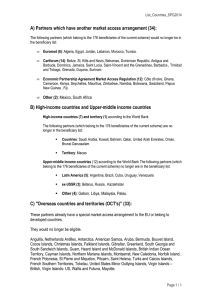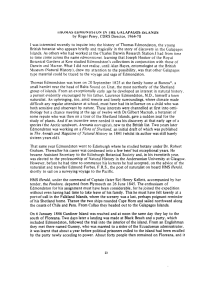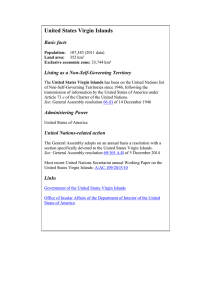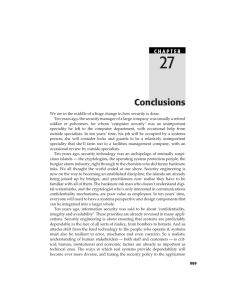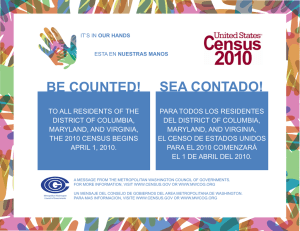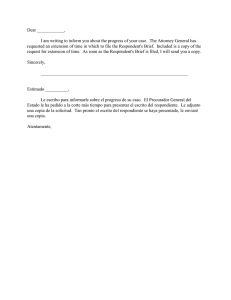first record of the least seedsnipe thinocorus rumicivorus in the
Anuncio
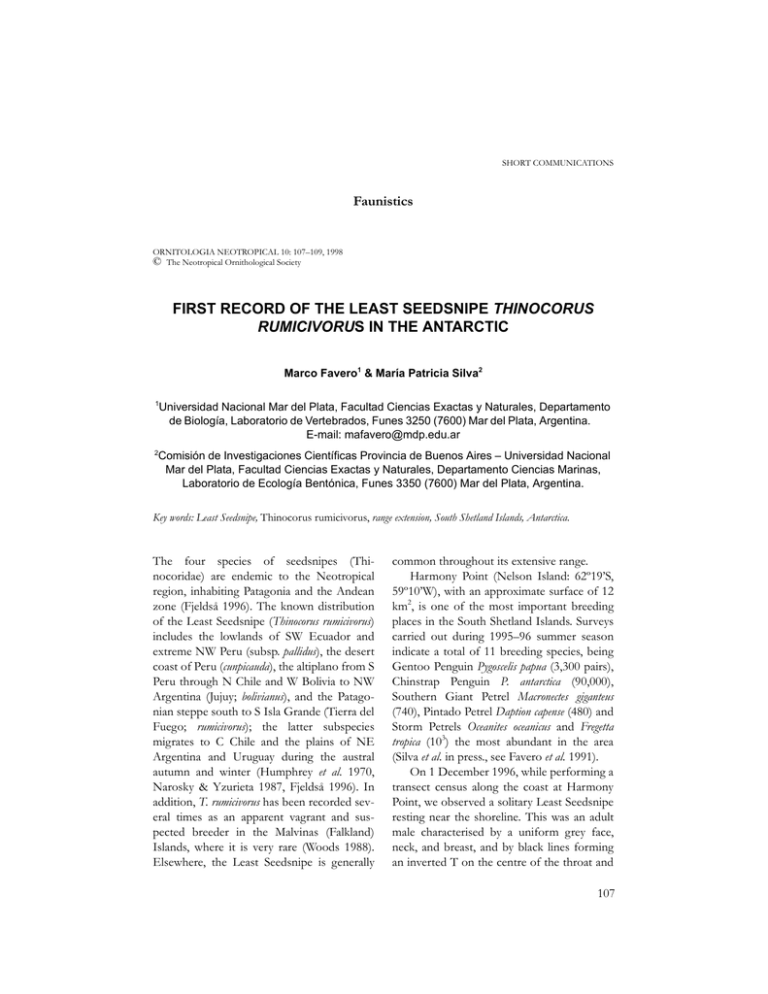
SHORT COMMUNICATIONS Faunistics ORNITOLOGIA NEOTROPICAL 10: 107–109, 1998 © The Neotropical Ornithological Society FIRST RECORD OF THE LEAST SEEDSNIPE THINOCORUS RUMICIVORUS IN THE ANTARCTIC Marco Favero1 & María Patricia Silva2 1 Universidad Nacional Mar del Plata, Facultad Ciencias Exactas y Naturales, Departamento de Biología, Laboratorio de Vertebrados, Funes 3250 (7600) Mar del Plata, Argentina. E-mail: mafavero@mdp.edu.ar 2 Comisión de Investigaciones Científicas Provincia de Buenos Aires – Universidad Nacional Mar del Plata, Facultad Ciencias Exactas y Naturales, Departamento Ciencias Marinas, Laboratorio de Ecología Bentónica, Funes 3350 (7600) Mar del Plata, Argentina. Key words: Least Seedsnipe, Thinocorus rumicivorus, range extension, South Shetland Islands, Antarctica. The four species of seedsnipes (Thinocoridae) are endemic to the Neotropical region, inhabiting Patagonia and the Andean zone (Fjeldså 1996). The known distribution of the Least Seedsnipe (Thinocorus rumicivorus) includes the lowlands of SW Ecuador and extreme NW Peru (subsp. pallidus), the desert coast of Peru (cunpicauda), the altiplano from S Peru through N Chile and W Bolivia to NW Argentina (Jujuy; bolivianus), and the Patagonian steppe south to S Isla Grande (Tierra del Fuego; rumicivorus); the latter subspecies migrates to C Chile and the plains of NE Argentina and Uruguay during the austral autumn and winter (Humphrey et al. 1970, Narosky & Yzurieta 1987, Fjeldså 1996). In addition, T. rumicivorus has been recorded several times as an apparent vagrant and suspected breeder in the Malvinas (Falkland) Islands, where it is very rare (Woods 1988). Elsewhere, the Least Seedsnipe is generally common throughout its extensive range. Harmony Point (Nelson Island: 62º19’S, 59º10’W), with an approximate surface of 12 km2, is one of the most important breeding places in the South Shetland Islands. Surveys carried out during 1995–96 summer season indicate a total of 11 breeding species, being Gentoo Penguin Pygoscelis papua (3,300 pairs), Chinstrap Penguin P. antarctica (90,000), Southern Giant Petrel Macronectes giganteus (740), Pintado Petrel Daption capense (480) and Storm Petrels Oceanites oceanicus and Fregetta tropica (103) the most abundant in the area (Silva et al. in press., see Favero et al. 1991). On 1 December 1996, while performing a transect census along the coast at Harmony Point, we observed a solitary Least Seedsnipe resting near the shoreline. This was an adult male characterised by a uniform grey face, neck, and breast, and by black lines forming an inverted T on the centre of the throat and 107 FAUNISTICS FIG. 1. Least Seedsnipe male at Harmony Point, Nelson Island, South Shetland Islands, 1 December 1996. Photograph by M. Favero. upper breast. The bird was found during the three succeeding days near the shore, apparently in good condition and pecking on the extensive moss surfaces present in the area (Fig. 1). Seedsnipes have not been previously reported in the Antarctic. Prior to our report, the southernmost record of the Least Seedsnipe was apparently a small chick observed by Jehl & Rumboll (1976: 149) at Ea. La Indiana, south-eastern Isla Grande on 25 January 1975, about 1000 km to the north of our field site on Nelson Island. In Patagonia, to judge from known egg dates (Fjeldså 1996), Thinocorus rumicivorus is known to breed approximately from August until February; thus its occurrence on Nelson Island in December coincides with the approximate middle of the breeding season. 108 The Least Seedsnipe may now be added to the list of several bird species, including some shorebirds, swans and egrets, that are widely distributed in the southern part of South America and that also occur as vagrants in the Antarctic. Among others, the Whiterumped Sandpiper Calidris fuscicollis was seen in the South Shetland Islands at Livingston (Gajardo & Yañez 1982), Nelson and King George Islands (Bannasch et al. 1984, Bannasch 1984, Trivelpiece et al. 1987, Lange & Naumann 1990, Silva et al. 1995). Blacknecked Swans Cygnus melancorhyphus have been reported at Charlotte Channel (64°40'S)(Bennett 1922), South Shetland Islands and other localities in the Antarctic Peninsula (Lazo & Yañez 1989, Parmelee & Fraser 1989, Lange & Naumann 1990, Favero et al. 1991, Silva et al. 1995). Cattle Egrets Bubulcus ibis were SHORT COMMUNICATIONS reported in the Antarctica at South Orkney Islands (Rootes 1988), South Shetland Islands (Schlatter & Duarte 1979, Torres et al. 1986, Trivelpiece et al. 1987, Lange & Naumann 1990, Favero et al. 1991, Silva et al. 1995) and Argentine Islands (Prince & Croxall 1983). Among the explanations for vagrancy offered by the above cited authors, the most common cause seems to be exceptional weather conditions that force birds to move out of their normal distribution. We hypothesise that the same explanation may account for the occurrence of Thinocorus rumicivorus in the South Shetland Islands. REFERENCES Bannasch, R. 1984. Bemerkenswerte Vogelbeobachtungen in der Antarktis. Beitr. Vogelkd. 30: 149–152. Bannasch, R., K. Feiler, & M. Rauschert. 1984. Fortsetzung der biologischen Untersuchungen im Gebiet der sowjetischen Antarktisstation Bellingshausen. Geod. Geophys. Veröff. Reihe I, H, 11: 3–63. Bennett, A. G. 1922. Nota sobre aves subantárticas. Hornero 2: 255–258. Favero, M., P. J. Bellagamba, & M. Farenga. 1991. Abundancia y distribución espacial de las poblaciones de aves de Punta Armonía y Punta Dedo, Isla Nelson, Shetland del Sur. Riv. Ital. Ornitol. 61: 85–96. Fjeldså, J. 1996. Family Thinocoridae (Seedsnipes). Pp. 538–545 in del Hoyo, J., A. Elliott, & J. Sargatal (eds.). Handbook of the birds of the world, Vol. 3: Hoatzin to auks. Linx Edicions, Barcelona. Gajardo, G. M., & J. Yañez. 1982. Primer registro de Calidris fuscicolis (Vieillot, 1819), en Isla Livingston, Shetland del Sur, Antartica (Aves: Scolopacidae). INACH Ser. Cient. 29: 69–71. Humphrey, P. S., D. Bridge, P. W. Reynolds, & R. T. Peterson. 1970. Birds of Isla Grande (Tierra del Fuego). Smithsonian Institution, Washington D.C. Jehl, J. R., Jr., & M. A. E. Rumboll. 1976. Notes on the avifauna of Isla Grande and Patagonia, Argentina. Trans. San Diego Soc. Nat. Hist. 18: 145–154. Lange, Von U., & J. Naumann. 1990. Weitere erstnachweise von vogelarten im südwesten von King George Island (Südshetland Inseln, Antarktis). Beitr. Vogelkd. 36: 165–170. Lazo, Y., & J. Yañez. 1989. First record of Blacknecked Swan Cygnus melancorhyphus in South Shetland Islands and Antarctica. Polar Rec. 25: 354. Narosky, T., & D. Yzurieta. 1987. Guía para la identificación de las aves de Argentina y Uruguay. Asociación Ornitológica del Plata. Buenos Aires. Parmelee, D. F., & W. R. Fraser. 1989. Multiple sightings of Black-necked Swans in Antarctica. Am. Birds 43: 1231–1232. Prince, P. A., & J. P. Croxall. 1983. Birds of South Georgia: New records and re-evaluations of status. Br. Antarct. Surv. Bull. 59: 15–27. Rootes, D. M. 1988. The status of birds at Signy Island, South Orkney Islands. Br. Antarct. Surv. Bull. 80: 87–119. Schlatter, R. P., & W. E. Duarte. 1979. Nuevos registros ornitológicos en la Antartica Chilena. INACH Ser. Cient. 25: 45–48. Silva, P., M. Favero, N. Coria, & R. Casaux. 1995. New records on Bubulcus ibis, Cygnus melancorhyphus and Calidris fuscicolis at South Shetland Islands, Antarctica. Mar. Ornithol. 23: 65–66. Silva, M. P., M. Favero, R. Casaux, & A. Baroni in press. The status of breeding birds at Harmony Point, Nelson Island, Antarctica in summer 1996/96. Mar. Ornithol. 27. Torres, D., M. Gajardo, & J. Valencia. 1986. Notas sobre Bubulcus ibis y Eudyptes chrysolophus en las Islas Shetland del Sur. INACH Ser. Cient. 34: 73–79. Trivelpiece, S. G., G. R. Geupel, J. Kjelmyr, A. Myrcha, J. Sicinski, W. Z. Trivelpiece, & A. Volkman. 1987. Rare bird sightings from Admiralty Bay, South Shetland Islands, Antarctica 1976–1987. Cormorant 15: 59–66. Woods, R. W. 1988. Guide to birds of the Falkland Islands. Anthony Nelson, Oswestry, U.K. Accepted 16 July 1998. 109
